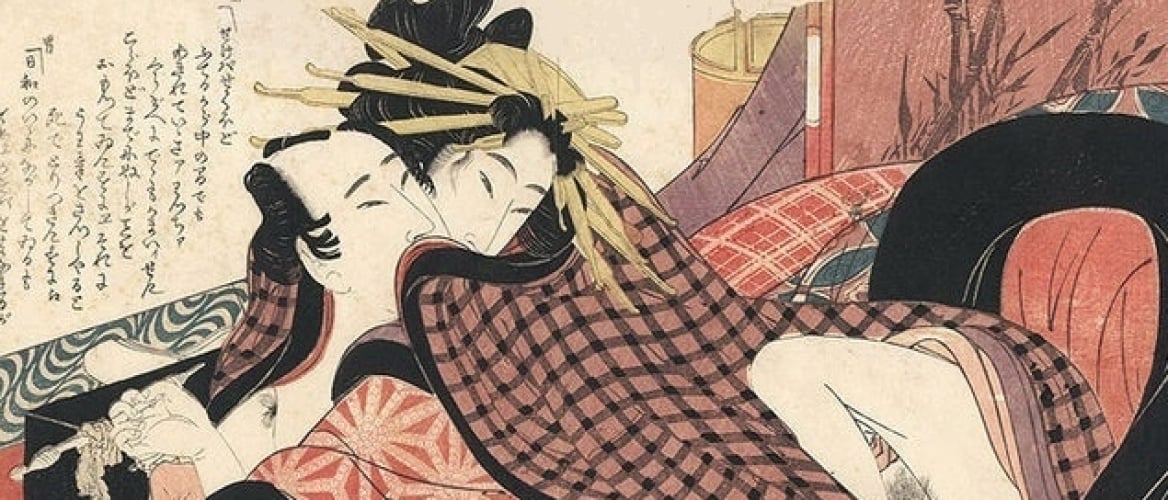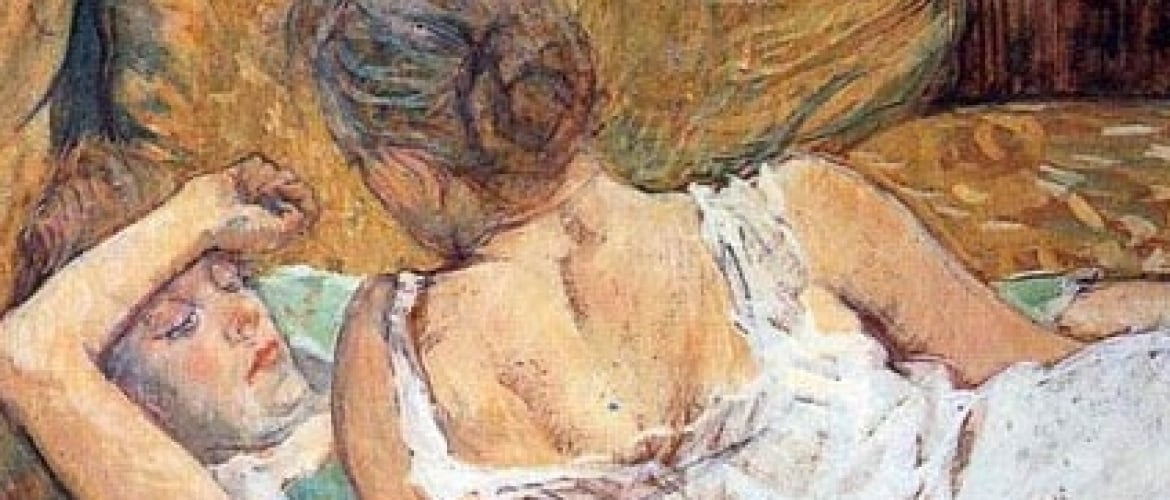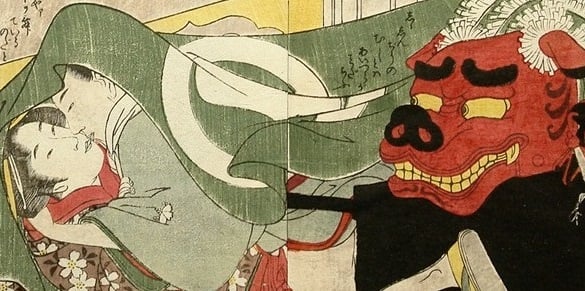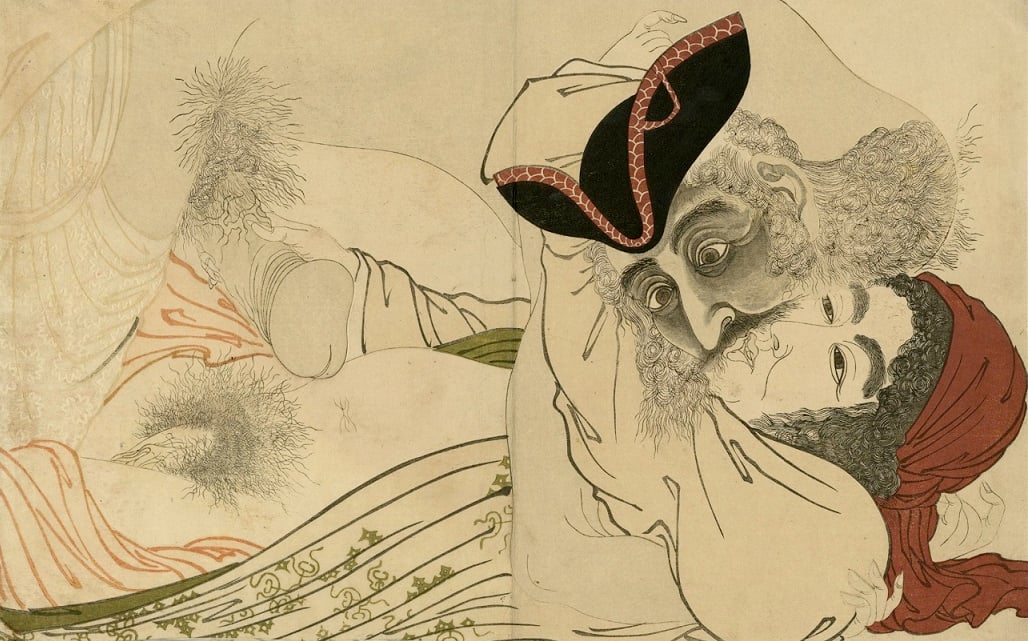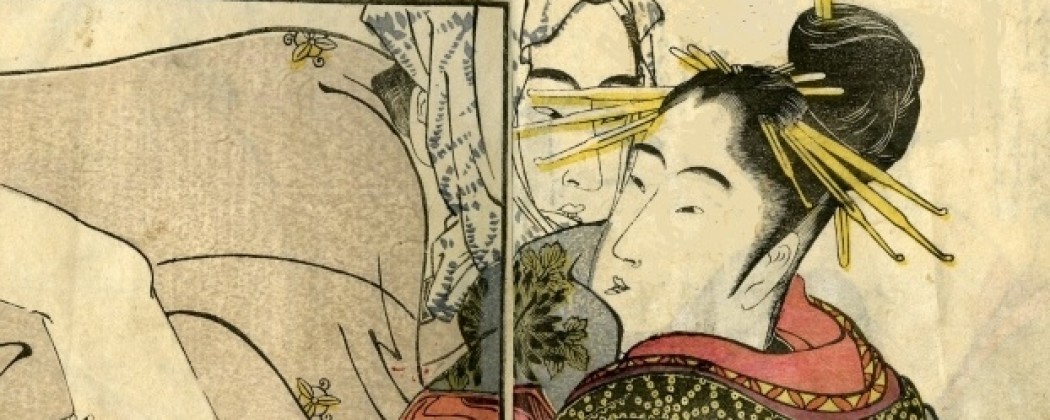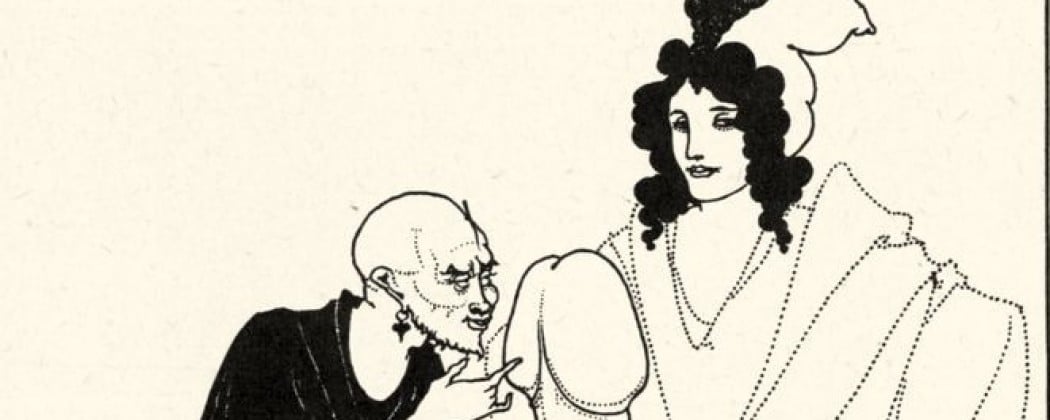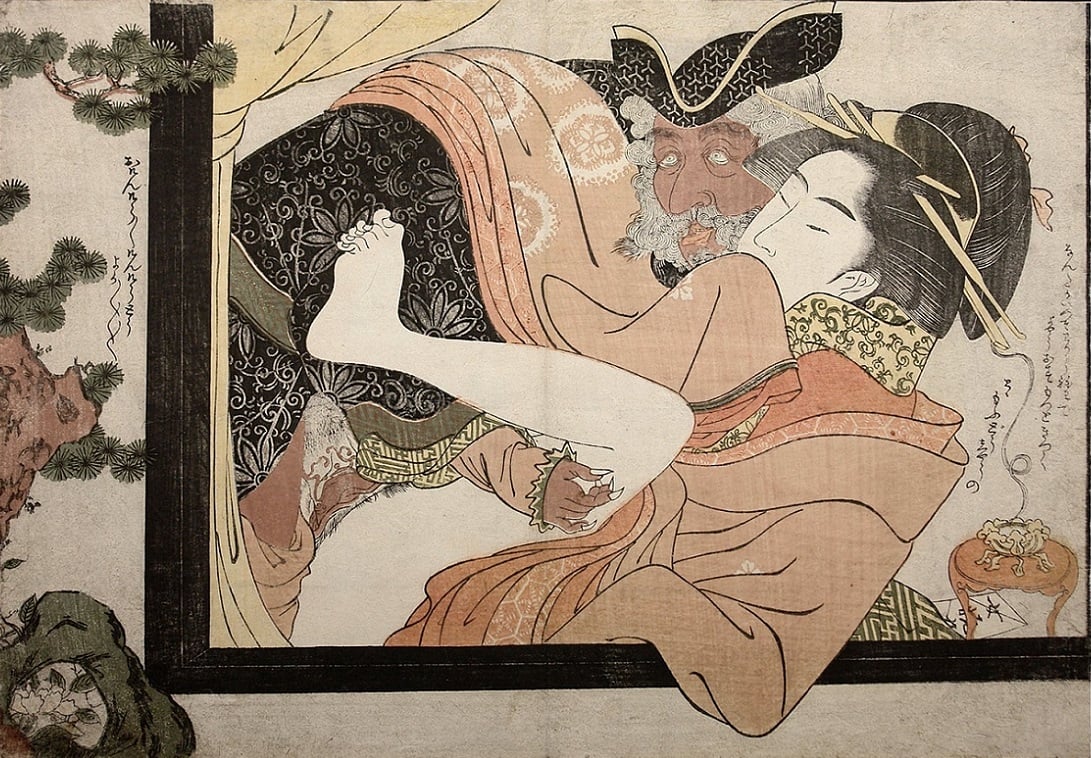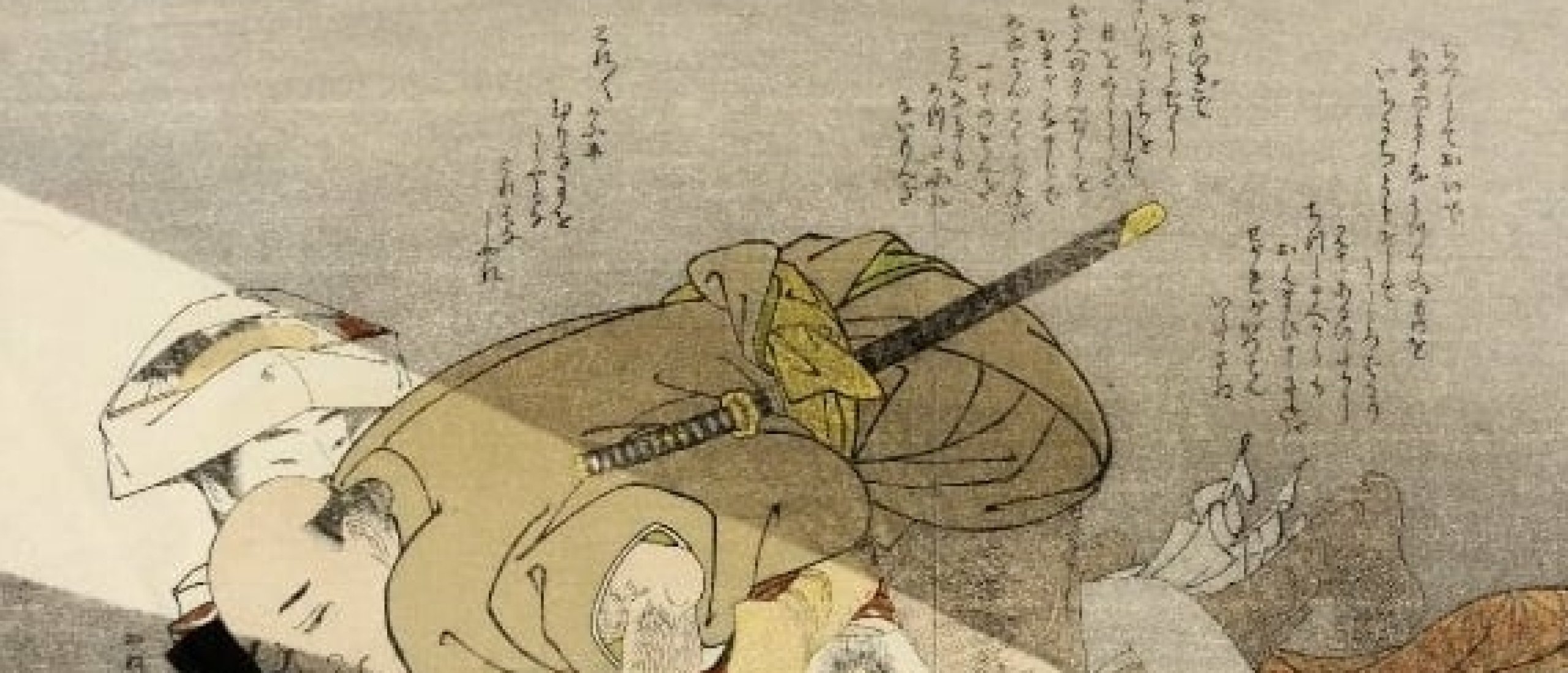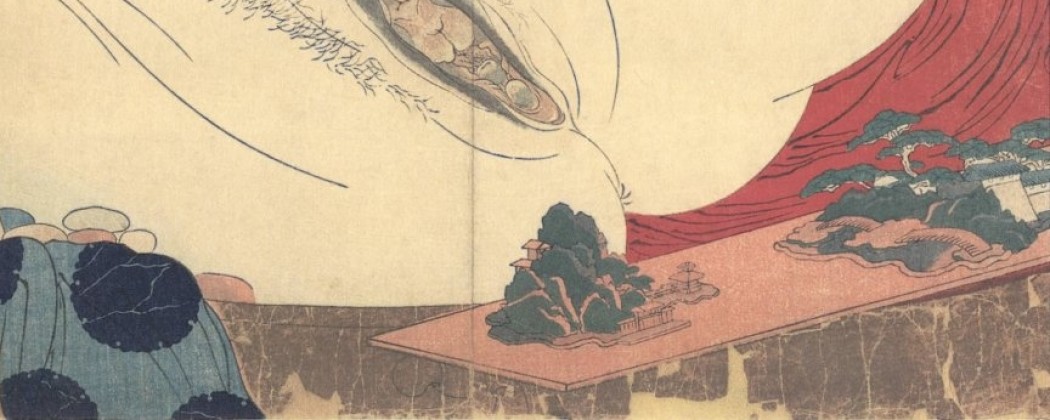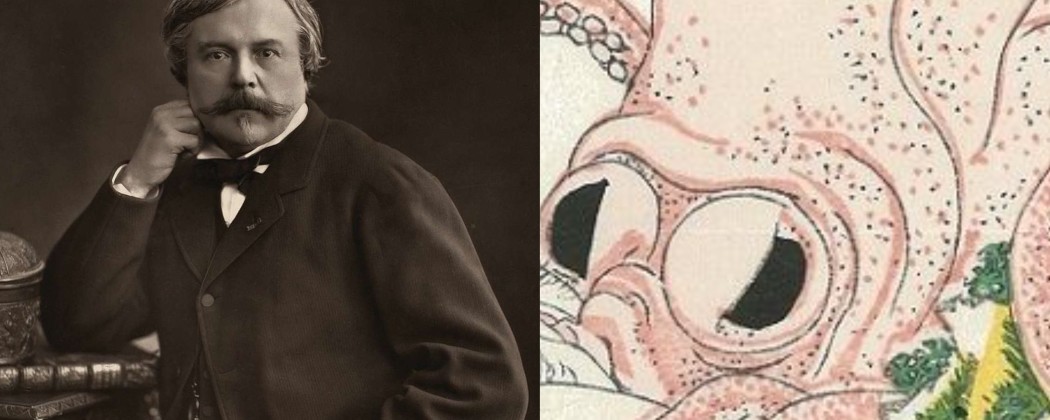
When it concerns shunga, Toulouse-Lautrec seemed specifically fascinated by Utamaro’s ‘Poem of the Pillow’ (Utamakura – see Fig.1.)‘, 1788. He acquired a copy of it from Edmond de Goncourt (1822-1896). The latter described the series as follows:
Brilliant Contrast
“The Poem of the Pillow, a marvelously printed work, with a harmony, I repeat, has no equivalent in European prints, and in which the clarity of the nude figures contrasts brilliantly with the luminous color of the silk robes, scattered by amorous liaisons, and in which the fauve color of the Mounds of Venus [public area] is highlighted voluptuously against the whiteness of the pinkish feminine skin.”

Fig.1. ‘Lovers in a private room in a teahouse‘ (1788), oban format, from the series ‘Poem of the Pillow‘ by Kitagawa Utamaro

Fig.2. ‘Two lovers (Les deux amies)‘, 1895. Henri de Toulouse-Lautrec
Moulin Rouge
The influence of printed ukiyo-e imagery on Lautrec’s work is deep-rooted. This can be seen in the application of the ink, the use of color and the placement of the composition in his posters like Moulin Rouge (1891 – see Fig.3.), Divan japonais (1892), or Jane Avril (1893), and is equally apparent in his drawings, paintings, and prints.

Fig.3. Poster for the ‘Moulin Rouge’ (c.1891) by Henri de Toulouse-Lautrec
Mass Reprographic Technology
Furthermore, Toulouse-Lautrec’s art is connected with ukiyo-e prints technically through the use of mass reprographic technology, as well as thematically through the depiction of the world of popular entertainment in the theaters and the brothels. He was particularly drawn to shunga, which shaped the core of his Japanese print collection.
Bohemian Life
The first erotic works by Toulouse-Lautrec date to 1882, when the artist settled permanently in Paris. His drawings and oil paintings from this period, which depict the brothels he frequently visited and the Parisian bohemian life he observed, display a Japanese influence. This can be seen in the types of patterns, the compositional style, and the palette he applied.

Fig.4. ‘Sleep (le Sommeil)‘, 1883-1885, Monotype by Edgar Degas
Related to Shunga
Some of these works by Lautrec were very similar to Degas’s earlier (see Fig.4.) but only a few of his surviving works can be related to shunga. The paintings that have a dialogue with shunga are the images of Parisian prostitutes and sensualised pictures of maisons closes from 1892 to 1896. In these, Toulouse-Lautrec portrays erotic semi-naked lesbians and filles de maison (prostitutes), locked in embraces, gazing at one another, or in repose.
Secretive Side
The amorous scenes – The Kiss (c.1892 – see Fig.5.), In Bed (c.1892) or The Sofa (c.1894-96) – expose Toulouse-Lautrec’s more secretive side, but one nevertheless influenced by Degas’s monotypes and shunga. However, these paintings are not images of explicit sex; they utilize the same subtle visual language that Utamaro applied in Poem of the Pillow.

Fig.5. ‘The Kiss‘ by Henri de Toulouse-Lautrec
Chronicler of Prostitutes
In the monograph Outamaro Goncourt created the image of Utamaro as “the painter of the maisons vertes“. Maisons vertes is a straightforward translation of the Japanese word seiro,which means “green house,”or brothel. Because Toulouse-Lautrec was a frequent visitor of the high-class Parisian establishments he became Utamaro’s counterpart and was known by the moniker “the Utamaro of Montmartre”.
Twelve Hours in Yoshiwara
Toulouse-Lautrec evolved into the chronicler of prostitutes’ lives, as seen in the set he designed for the magazine Elles (see Fig.6.), which depicts the twelve hours within the daily life of a prostitute. This was inspired on Utamaro’s The Twelve Hours in Yoshiwara (Seiro juni toki tsuzuki, 1794). What is striking is that some of these high-class sex etablishments offered shunga prints to their clients. So it was quite possible that clients of these brothels, who most probably were neither collectors nor Japanese art devotees, were the first to encounter Japanese erotic imagery at these locations.

Fig.6. ‘Cover for Elles (1896)’, Color lithograph, 52,2 x 40,4cm (20 1/2″ x 16″) by Henri de Toulouse-Lautrec
Island of Women
Dr. Louis Fiaux, an expert on prostitution, mentions this fact in his book Les Maisons de Tolérance (1892). He refers to the fanciful Japanese “Island of Women,” traditionally seen in some erotic scroll paintings, shunga prints, and illustrated books:
“The collection in the wealthy brothels contained licentious images from the Far East. Japan is represented among these…its contingent of extraordinary fantasy transmitted by the Island of Women [Nyogogashima], the Island of Men, and so forth. The brothel owner’s museum can possess all: it is inviolate.”
Click HERE for an article on the sex adventures of three castaways on the Island of Women….!!
Source: ‘Erotic Japonisme, the Inflluence of Japanese Sexual Imagery on Western Art‘ by Ricard Bru
Let us know your thoughts on Lautrec’s work in the comment box below…!!

